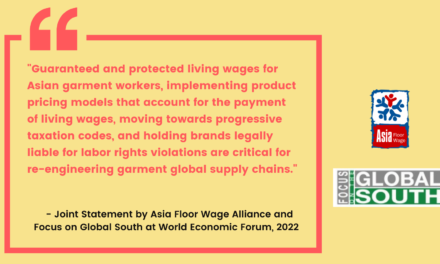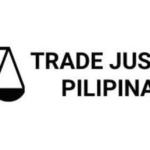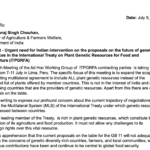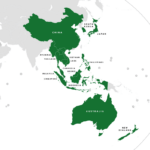September 2002
Apartheid is not dead, it is very much alive and of all ironies, it was reinforced in the country where it was most bitterly fought. Apartheid at a global level has in fact, just been successfully institutionalised with the conclusion of the World Summit on Sustainable Development in Johannesburg, South Africa.
This time, though, apartheid is no longer a policy of racial segregation, it is a system of discrimination based on economic and military power. But the objective remains the same, to keep the oppressed in their place, the poor mired in their poverty, to keep the status quo.
OMINOUS BEGINNINGS
Even before the Summit began, things looked ominous with officials setting up event sites ridiculously far from one another. The Sandton Convention Center, where the official meetings and negotiations were to be held, sat in the richest district of Johannesburg while the parallel NGO events of the “Global Peoples Forum” were 30 kilometers away at the NASREC centre, taking a good one hour by bus ride to get there from Sandton. The two other official sites, the Ubuntu Village where the country, business and civil society exhibits were, was 15 kilometers away from Sandton while the Waterdome was literally a world away, taking at least two hours by bus — on a good day.
True, there were “Summit Shuttles” between the venues, but the sheer distance made you lose hours on the bus. It also discouraged official government delegates and ministers from meeting their civil society counterparts.
The great distance between the sites though, made people suspect if this was done deliberately to separate and exclude many from the process.
This suspicion was reinforced just days before the official Summit opening when South African police arrested more than seventy peaceful protesters from the National Land Council (NLC) and the Landless Peoples’ Movement (LPM). The unwarranted arrests were indicative of things to come.
DOES FREE TRADE AFFECT ME?
While the landless, the poor and activists were obviously unwelcome, representatives of the transnational corporations were not only welcome, they were being given red carpet treatment.
All over Johannesburg, huge billboards advertising the Summit littered the landscape, competing with the commercial ads selling insurance or half-priced airline tickets to Cape Town. They were literally everywhere, from the decrepit buildings of downtown Johannesburg to the glossy skyscrapers of Sandton. One showed a smiling farmer with the question above his head “Does Free Trade Affect Me?” Others depicted similar dramas of smiling people from the third world with sappy lines on sustainability. What they had in common — aside from the tacky UN stamp — were the corporate logos: BMW, Hewlett Packard, Daimler Chrysler, all the big boys were all there with slogans proclaiming their sustainability and their proud sponsorship of the Summit. Eskom bought the chairs, HP brought the technology, and BMW brought the cars.
Their presence was overwhelming. Upon entering the Sandton Convention Center, you were greeted by a massive half-globe with mini tents beside it. This was the BMW “Earth Lounge” where they served free wine and fruits to delegates taking in the wonders of the very sustainable and supposedly affordable hydrogen cars of the German company. Incredibly, while everyone else was crammed into the far-flung exhibition centres, BMW had the Sandton Convention Center all to itself.
But then again, the special treatment should hardly be surprising: this UN summit had the largest business presence ever. The count by the ‘Summit Star’ totaled over 700 business executives, 200 companies and more than 100 CEOs.
And why would corporations not come out in full force, when the UN’s priorities have shifted from poverty eradication and environmental preservation to achieving sustainable development via “public-private” partnerships with these big boys or as Kofi Annan calls it, The Global Compact.
Corporations came to divide the world amongst themselves and privatise everything that matters, water, energy, healthcare, agriculture and biodiversity. If the way globalization has been run in the past few decades is any indication, corporations taking over can only spell disaster for the poor, the landless, the South.
Some corporations cannot even be held accountable for past sins like Bhopal in India and Marcopper in the Philippines, where in both cases entire communities still suffer from these companies’ irresponsibility several years after the incident.
SUPPRESSING DISSENT
A few days into the Summit was all people needed to have their worst fears confirmed, that they were not invited nor wanted there. Yes, civil society delegates and representatives from progressives had official Summit ID’s that would ideally open all doors, but this was apparently not enough. At almost all official deliberations and meetings at the Sandton Convention Center, halls were closed with signs declaring that they were supposedly full.
Groups then focused on converging at Nasrec or at the Landless People’s Camp to discuss ways to let ministers hear the legitimate grievances of the people who they should be working for. Grievances of landlessness, poverty and even access to safe water, all of which, should be heard at the official meetings.
The meetings at Nasrec and elsewhere though were tense as droves of police and miltary persons were in attendance as well. In one hall that held about 150 people, there were more than fifty heavily armed police at the back of the hall. One march outside a university was actually dispersed with stun grenades, such was the extent of the show of military force by the South African government.
UNITED, WE WILL NEVER BE DEFEATED
Suppression though, as greek mythology has shown, will only make the flame burn hotter and on the bright day of August 31, the social movements, the landless and internationalists joined together to burn the hand clamping down on them.
20,000 people marched the ten kilometer stretch from one of the poorest towns, Alexandra to the posh district of Sandton, carrying a Social Movements United banner along with all the other banners of all the groups that joined in, the Landless People’s Movement, the Anti-Privatization Forum and many others. It was awe-inspiring, people marching under the Johannesburg sun, singing, holding hands and calling people in their houses to come out and join. It was a site of unity in diversity with the South Africans teaching their international comrades and colleagues how to toyi-toyi, or marching while dancing and chanting Land, Food, Jobs, Land for the Landless and Viva Viva Palestina and Argentina.
The enthusiasm was at a high despite the intimidation of at least 8,000 police officers plus tanks, helicopters, barricades and riot police with plastic shields and shotguns.
The end of the march though proved to be frightening for the sheltered ministers. None of the ministers, not even Thabo Mbeki came out to meet the people. The speeches were at the Sandton Center where ministers and government delegates peered from the glossy buildings.
It was a victory as the mere joining of forces of the greatly varied groups showed the unity that could be achieved despite differences in many aspects. And it was because of this great diversity that the police were not able to employ their usual tactics of dispersing and bombing local marches. It was also a victory in that people excluded and oppressed came together in a show of force to say to the world that Summit has done nothing but sustain global apartheid. As the people have chanted, United, we will never be defeated.
* Marylou Malig is a research associate with Focus on the Global South







